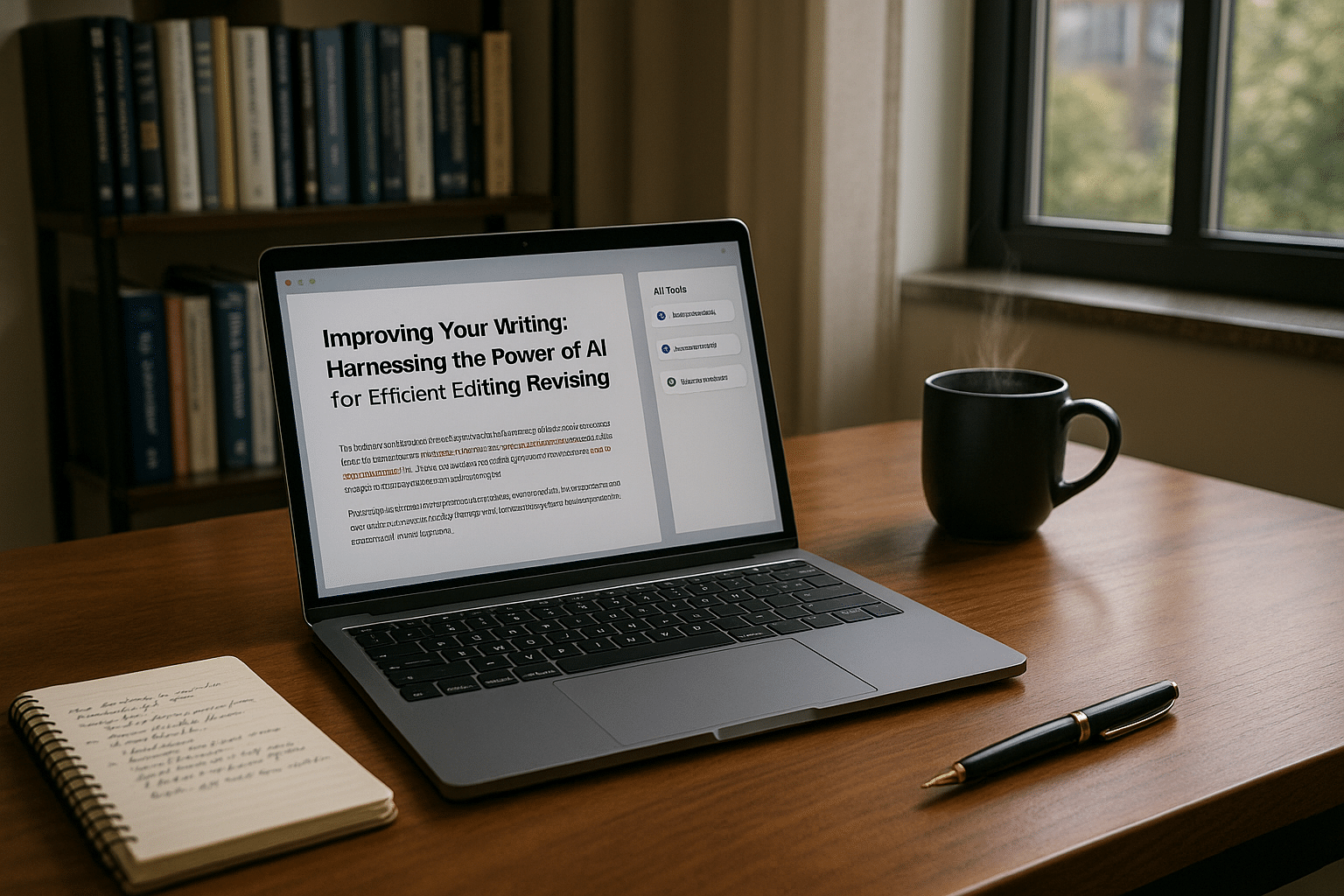Words now find their places in the digital universe, processed by algorithms and augmented by artificial intelligence (AI). The intertwining of writing and technology has opened up new horizons in terms of efficiency and quality, and that’s what we’re going to explore in this article. 👨💻
How can we harness the power of AI to improve our writing skills, and more specifically, to revolutionize the editing and proofreading process? How can we leverage this modern tool to create texts that are not only technically correct, but also engaging and persuasive? These are the questions we will be answering in this piece. So, whether you’re a seasoned professional writer, an enthusiastic newbie, or simply someone who wants to perfect your writing, you’re in the right place.
Unveiling the Power of AI in Writing 🚀
Artificial Intelligence, a term that once seemed confined to the realms of science fiction, has now permeated various facets of our lives, including the realm of writing. This technology has the potential to transform the way we write, edit and proofread our texts, boosting productivity and accuracy to unprecedented levels.
AI-powered tools can identify spelling and grammar errors, suggest better word choices, evaluate sentence structure, and even assess the overall tone of your text. But beyond these basic features, they can also provide insights on how to make your writing more engaging and effective. It’s like having a virtual writing assistant at your disposal, ready to help at any time.
Exploring the Intersection of Writing, Editing, and Proofreading with AI 🧩
Editing and proofreading are integral parts of the writing process, and they can significantly determine the quality of the final output. However, these tasks can be time-consuming and often require a high level of attention to detail. This is where AI comes in. By automating these tasks, AI can help you save valuable time and ensure that your text is as polished as possible.
But how exactly does this work? How can AI assist in refining your writing? Well, in the following sections, we will delve into the intricacies of AI-based editing and proofreading tools, and how they can make your writing journey smoother and more rewarding.
Getting Ready for a Deep Dive into AI for Writing 🏊♂️
Are you ready to dive into the world of AI and explore how it can enhance your writing prowess? Whether you’re writing a blog post, a research paper, or a business proposal, the ability to effectively communicate your ideas is a skill worth mastering. And with the help of AI, you can take your writing to the next level.
In the following sections, we will discuss the role of AI in enhancing editing and proofreading efficiency, exploring various AI-based tools and their features. We will also provide tips on how to make the most of these tools, and shed light on the future prospects of AI in writing.
So, buckle up and get ready for a journey into the exciting intersection of technology and writing, where we will uncover the power of AI to transform your writing process. Let’s get started! 🚀
🚀 Embracing the Future: The Intersection of Writing and Artificial Intelligence
In a world where technology is rapidly evolving and impacting nearly every facet of our lives, the realm of writing is no exception. With the advancement of Artificial Intelligence (AI), the writing landscape is being reshaped, offering unprecedented efficiency in editing and proofreading tasks. Let’s delve into how AI can perfect your writing. Be prepared to have your mind blown with AI’s writing assistance capabilities!
Writing, in its traditional sense, has always been a human endeavor – a creative process involving a deep understanding of language, context, and the human experience. However, the emergence of AI in writing doesn’t aim to replace human writers, but rather to augment their capabilities, especially in the areas of editing and proofreading.
Whether you’re a seasoned professional writer or someone just getting started, AI can enhance your writing proficiency, making your content more concise, compelling, and free of errors. The magic lies in AI’s ability to learn and improve over time, eventually becoming an indispensable tool in your writing arsenal.
💡 Understanding AI’s Role in Editing and Proofreading
Before we plunge into the technical details of how AI assists in writing, it’s essential to understand the role of AI in editing and proofreading. Think of AI as your virtual assistant – tirelessly working in the background, ready to catch those pesky grammar mistakes, misspellings, and even subtle nuances like tone and style inconsistencies that might slip past your human eyes.
One of the main advantages of using AI for editing and proofreading is its ability to process large amounts of text quickly, saving you precious time and energy. Moreover, AI algorithms are capable of learning and adapting, thus improving their efficiency over time. Isn’t that fantastic? Now, let’s deep-dive into how exactly AI accomplishes these feats.
🔎 Unveiling the Mechanics: How AI Enhances Writing
AI improves writing efficiency through a combination of Natural Language Processing (NLP), machine learning, and deep learning techniques. These sophisticated technologies work together to understand the context, grammar, and semantics of the text, allowing AI to make accurate suggestions and corrections.
NLP, the cornerstone of AI in writing, enables machines to understand, interpret, and generate human language. This technology is the driving force behind AI’s ability to check for grammatical errors, suggest synonyms, improve sentence structure, and even check for tone and style consistency.
Machine learning, on the other hand, allows AI to learn from its mistakes and improve over time. By analyzing vast amounts of data, AI can spot patterns and trends, helping it understand and mimic the complexities of human language. It’s like having a personal language tutor that never gets tired!
📊 A Comparative Analysis: AI vs Human Editing and Proofreading
| AI Editing and Proofreading | Human Editing and Proofreading | |
|---|---|---|
| Speed | Can process large amounts of text quickly | Time-consuming, especially for lengthy documents |
| Accuracy | High accuracy in catching grammar and spelling mistakes | May overlook subtle errors |
| Learning Ability | Continuously learns and improves over time | Learning speed depends on individual capability |
| Consistency | Can maintain tone and style consistency throughout the document | May struggle with maintaining consistency in long documents |
For a more visual understanding of AI in writing, check out the following YouTube video: “AI in Writing: Friend or Foe?” by Wired. You’ll find it insightful!
🧰 Tools of the Trade: AI Writing Assistants
Now that we’ve covered the mechanics of AI in writing, it’s time to introduce you to some of the top AI writing assistants available today. These tools are revolutionizing the way we write, and after exploring them, you’ll surely want to harness their power!
Grammarly is a well-known AI writing assistant that goes beyond basic grammar and spell check. It offers real-time suggestions to enhance your writing, checking for clarity, engagement, and delivery. Whether you’re working on an academic paper, a business proposal, or a blog post, Grammarly has got your back!
Another noteworthy tool is QuillBot, a state-of-the-art paraphrasing tool that uses AI to rephrase your sentences without changing their meaning. It’s perfect for overcoming writer’s block or just adding some variety to your writing.
Finally, Wordtune is an AI-powered writing companion that helps you say exactly what you mean. It offers real-time suggestions to improve the fluency and authenticity of your writing, making your message more compelling.
📚 Learning to Leverage AI for Writing: Resources
While AI writing tools can greatly enhance your writing efficiency, it’s crucial to learn how to leverage these tools effectively. Below are some resources that will help you get the most out of AI for writing:
- Course: “Artificial Intelligence for Writers” by Udemy
- Book: “Writing with Machines: An Overview of AI and Writing” by Paul Roetzer
- Podcast: “The AI in Writing” by The AI Alignment Podcast
By leveraging AI’s power, you can enhance your writing like never before, delivering high-quality, error-free content faster and more efficiently. The future of writing is here, and it’s AI-powered. Are you ready to embrace it?

Conclusion
Conclusion
As we wrap up this engaging and informative discourse, it is imperative to recapitulate the salient points touched upon, emphasizing their importance in the world of Information Technology and Engineering. The objective of this article was to clarify complex concepts, and I hope that I have achieved this aim effectively.
We embarked on a journey together, exploring the intricacies of software engineering, its concepts, and principles, and how they serve as the backbone for the digital world we live in today. We delved deep into the working of various algorithms, data structures, and coding languages, unveiling the logic behind their operation. 💡
We dissected the various development methodologies like Agile, Scrum, and Waterfall, and highlighted their significance in building robust, efficient software systems. We also emphasized the importance of security and ethical practices in software engineering, to protect user data and uphold user trust.
In the realm of IT, we unraveled the mystifying world of cloud computing, big data, and artificial intelligence. We examined their profound impact on businesses and society at large, and how they are shaping the future. We further investigated the role of IT in cybersecurity, a domain of increasing relevance in today’s interconnected world. 🔒
It is my hope that this knowledge will not merely remain a theoretical understanding but will be applied practically, leading to further innovation and advancement. The importance of the topics discussed cannot be understated in our increasingly digital world, and a solid understanding of these concepts is crucial for any IT and Engineering professional.
Remember, the journey of learning is never-ending, and there’s always more to explore and understand. So, let’s keep the conversation going. Feel free to leave your comments, share your insights or even challenge the concepts discussed. Let’s stimulate a healthy discussion to facilitate learning for everyone. 🌐
Moreover, I encourage you to share this article with others who might find it beneficial. Knowledge, after all, is meant to be shared.
Thank you for staying with me throughout this discourse. It is your curiosity and thirst for knowledge that makes writing such pieces worthwhile. Stay tuned for more such articles where we will continue to demystify complex technical concepts. 🚀
For more reading, you may want to check out these sources:
IEEE Xplore
Association for Computing Machinery
References:
[1] ACM Digital Library
[2] IEEE Computer Society Digital Library
Keep Learning, Keep Growing!



